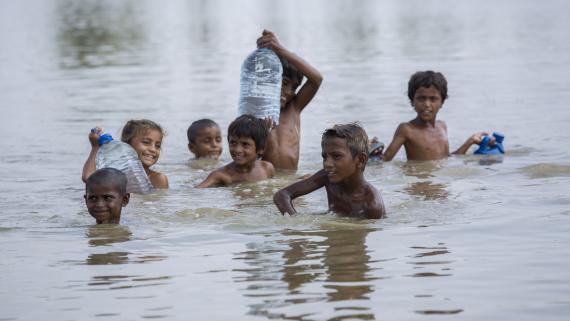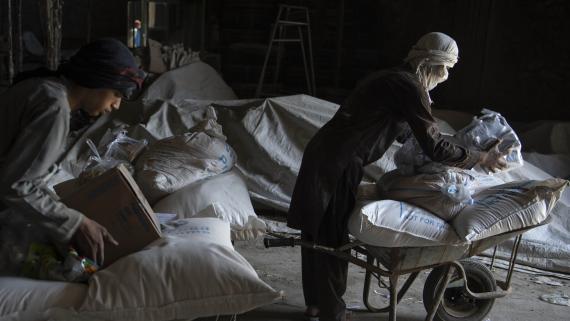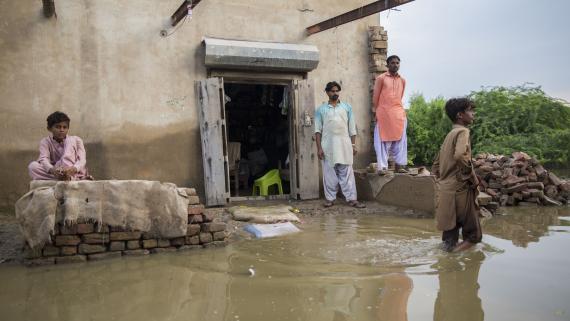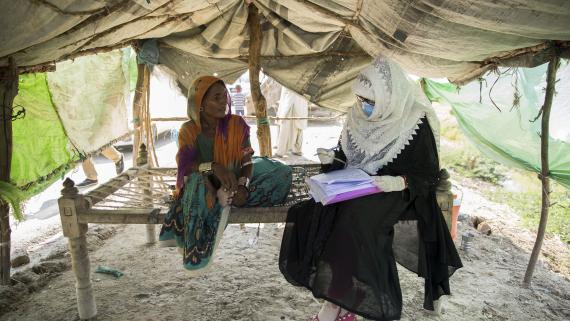Kachin State, Myanmar
When the gates of Maina IDP camp closed in April, the family of this 9-year-old Kachin internally displaced girl, were not prepared to face the financial and mental challenges to come. Her mother weaved traditional dresses – longgyis – and her father was a labourer. But with the camp gates closing it became nearly impossible to work. Despite receiving some money each month, the family struggled to make ends meet to even afford the basics. UNICEF/Minzayar Oo
The COVID-19 pandemic has severely affected the Asia and the Pacific region. The first case outside of China was reported in Thailand in January 2020, after which the disease quickly spread to other countries in the region. Despite strict measures to contain the virus, many countries are still experiencing severe outbreaks and far-reaching impacts.
As of November, over 12.1 million cases have been reported in 39 countries in the region and at least 222,000 deaths attributed to the disease. Even in countries with fewer reported cases, there have been severe impacts on livelihoods, household income and poverty, food security, access to medical care for non-COVID-19-related concerns including maternal and child health care, and protection concerns including rising rates of sexual and gender-based violence and child protection.
The UN supported 15 multisector response plans, covering 27 countries related to COVID-19, of which seven were included in the Global Humanitarian Response Plan. In total, these 15 plans are seeking some US$1.71 billion and targeting over 70 million people. Nationally led COVID-19 health plans requested an additional $1.5 billion.

Mirpurkhas, Pakistan
Children fill bottles and play in one of the areas hardest hit by monsoon flooding in rural Sindh in September. Almost 10,000 families in Sindh receive food assistance from WFP.
WFP/Saiyna BashirThe need to maintain effective response readiness despite the challenges of COVID-19 is critical in Asia and the Pacific; it remains the world’s most disaster-prone region, with three out of every four disaster-affected people living in the region. In the last five years, nearly 800 million people in Asia and the Pacific have been affected by a natural disaster and almost 50,000 people have been killed. In addition, over one quarter of the world’s conflicts occur in Asia and the Pacific. In recent years violence has intensified, while the region now hosts 3.2 million refugees.
In 2020, there are 12 humanitarian response plans, refugee response plans or other coordinated international response plans covering 10 countries and requesting a total of more than $2.8 billion, targeting over 23 million people. In total, 29 countries in Asia and the Pacific have had some type of humanitarian response plan – more than at any time since the 2004 tsunami, with a total humanitarian ask of more than $4.5 billion. Despite these challenges, countries in Asia and the Pacific are increasingly becoming aid providers; in 2020 countries in Asia contributed more than $1.69 billion in humanitarian aid.
Projected situation in 2021 and beyond
The impacts of COVID-19 are expected to continue through 2021 and possibly beyond, with far-reaching public health consequences and impacts on humanitarian needs. Updated response plans to address the humanitarian needs arising from COVID-19 are already being planned in many countries, including Indonesia, Papua New Guinea and Nepal. Many more countries will likely face multiple compound disasters eroding coping capacities, raising the possibility that additional people will require humanitarian assistance.
Asia and the Pacific: Overview of appeals (2021)
In addition, a number of countries, including Papua New Guinea, Indonesia, Philippines and Timor-Leste, are identified as being at ‘high risk’ of La Niña in early 2021, which could result in localized flooding, landslides, damage to crops and an increase in waterborne diseases, and further exacerbate already heightened vulnerabilities and humanitarian need in these countries.
Evolution of People in Need (2020 vs. 2021)
Food security in Asia and the Pacific is expected to deteriorate in 2021 in countries including Afghanistan, Bangladesh, Nepal, Sri Lanka, Cambodia and Myanmar due to a combination of climatic shocks and socioeconomic challenges. Access and movement restrictions and social distancing are likely to continue, requiring increased use of remote assistance and changing response modalities, such as the use of mobile cash transfers.
Further reading
Source: OCHA
Source: OCHA
Source: OCHA
Afghanistan
Analysis of the context, crisis and needs
Forty years of war, recurrent natural disasters, increasing poverty and COVID-19 are devastating the people of Afghanistan. Conflict continues to drive extreme physical and psychological harm and has forcibly displaced 278,000 people in the first 10 months of 2020. Even after the start of intra-Afghan peace negotiations on 12 September 2020, civilian casualties remain high, with no sign of a lull in fighting. Women and children are disproportionately impacted, comprising 44 per cent of all civilian casualties in the first three quarters of 2020. Health facilities and workers continue to suffer from attacks and intimidation by parties to the conflict.
COVID-19 has resulted in reduced income for 59 per cent of households, while 17 per cent of recently assessed households have taken on catastrophic levels of debt, mainly to cover immediate food and health-care needs. An estimated 30.5 million people (those in IPC 2 and above) are at risk of requiring humanitarian assistance if they are left without urgent social assistance from the Government and development actors.

Charikar, Afghanistan
On 26 August, flash floods occurred across Parwan province, washing away hundreds of homes, killing several dozen people and injuring hundreds more. Flood victims received a pre-package of food from WFP, which has supported affected people by providing two months’ worth of food.
WFP/Massoud HossainiHunger and malnutrition have spiked amid the economic downturn, with food insecurity now on par with the 2018-19 drought. Over the past five years, the proportion of people in crisis or emergency situations has increased fourfold. In 2021, an estimated 16.9 million people, 42 per cent of the population, will be in crisis or emergency levels of food insecurity (IPC 3+) – the fifth highest proportion in the world. Almost one in two children under 5 years of age is now facing acute malnutrition and needs life-saving treatment. The pandemic also forced temporary school closures, leaving 10 million children out of school for most of the year and the vast majority with catch-up learning needs. Despite the heavy demand for WASH services in light of COVID-19, almost three quarters of the population in rural areas lack access to safe drinking water, sanitation and hygiene services.
Projected situation in 2021 and beyond
An estimated 18.4 million people need humanitarian assistance in 2021. This record number is almost double the number since the beginning of 2020 (9.4 million people), and it represents an increase of 31 per cent from the 2020 mid-year HRP revision (14 million people). This increase is driven by the social, economic and health impacts of COVID-19, high cross-border mobility, spiraling food insecurity and malnutrition, as well as conflict-driven displacement and protection needs. Results from the 2021 Joint Inter-Sectoral Analysis Framework indicate that all 34 provinces are considered to be in severe or extreme need, and more than half (19) are considered extreme.
High levels of debt, eroded livelihoods, continued conflict and repeated psychosocial trauma have exacerbated protection needs; 12.8 million people need protection assistance. Women are facing both an increased burden of care and GBV risks due to COVID-19. Additional protection assistance is needed for children who are increasingly required to work outside of home and are at heightened risk of early marriage, exploitation or recruitment into armed groups. With limited legal protection and increasing inability to secure employment, many households live under the threat of eviction.
Evolution of needs and requirements (2016 - 2021)
As humanitarians shifted response priorities to meet COVID-19-induced needs, unaddressed priorities from 2020 are likely to drive more severe needs in 2021, requiring urgent supplementary development assistance, especially in protracted displacement sites. Financial strains and fear of catching COVID-19 meant that facility-based primary health and trauma services were underutilized in 2020, resulting in deteriorating health needs in 2021. Development actors delayed the roll-out of social safety net assistance in 2020, which is also a factor in the escalating humanitarian needs for 2021.
The situation beyond 2021 remains uncertain. While the current intra-Afghan negotiations present an opportunity to reduce harm to civilians and address humanitarian needs, increased violence seems likely to dominate the path to any peace agreement. Regional dynamics and anticipated additional waves of COVID-19 have the potential to threaten a hoped-for economic recovery.
Response priorities in 2021
In 2021, humanitarian partners expect to reach 15.7 million people (71 per cent of PiN; 91 per cent of the planned reach). This assistance has not been as comprehensive or durable as intended due to funding shortfalls, but it still reflects a dramatic scale-up in activities to meet new and exacerbated needs due to COVID-19. Limited funding has forced stricter prioritization on life-saving assistance and lower-cost, high-reach activities, such as risk communications, community engagement or COVID-19 awareness-raising, rather than the more intersectoral package of assistance envisaged. While conflict, access challenges, interference by parties to the conflict and natural disasters demanded partners’ flexibility, humanitarians have maintained a presence and delivered some form of assistance in 390 of 401 districts in Q2 2020.
Afghanistan: a new beginning for IDPs
The Afghan village of Aman Abad hosts hundreds of families displaced by conflict in nearby regions. One of the IDPs shows how he is making the best out of the difficult circumstances for his family – with new shelter – but still struggling to earn a livelihood.
OCHA2021 is the final year of Afghanistan’s multi-year HRP (2018-2021). Humanitarian partners aim to assist 15.7 million people, requiring $1.3 billion. The increase in planned reach is mostly driven by the sharp increase in the number of people in acute food insecurity, and it reflects humanitarian partners’ proven capacity to scale-up, providing that resources are available. The response will also continue to emphasize the need to expand AAP work, reinforce the importance of PSEA, and strengthen gender, mental health and disability inclusion.
Further reading
Source: OCHA
Source: Humanitarian Insight
Source: Financial Tracking Service
Myanmar
Analysis of the context, crisis and needs
Myanmar continues to grapple with deeply rooted humanitarian challenges. An estimated 1 million people need some form of humanitarian support due to armed conflict, vulnerability to natural hazards or intercommunal violence. The expanding impact of the COVID-19 pandemic has further complicated the lives of people in humanitarian settings across the country.
More than 336,000 people in Myanmar are internally displaced, the majority of whom are in situations of protracted displacement. Overall levels of need have increased due to an expansion of armed conflict in Rakhine and southern Chin. This has caused civilian casualties and significant additional internal displacement since early 2019, with more than 100,000 IDPs reported as of November 2020.

Kachin State, Myanmar
When the gates of Maina IDP camp closed in April, the family of this 9-year-old Kachin internally displaced girl, were not prepared to face the financial and mental challenges to come. Her mother weaved traditional dresses – longgyis – and her father was a labourer. But with the camp gates closing it became nearly impossible to work. Despite receiving some money each month, the family struggled to make ends meet to even afford the basics.
UNICEF/Minzayar OoAn estimated 600,000 Rohingya who remain in Rakhine – 130,000 of whom are effectively confined to camps or camp-like settings established in 2012 – still cannot move freely. Movement restrictions severely limit their access to essential services, such as education and health care, and to livelihoods, which deepens their vulnerability and dependence on humanitarian aid.
Despite an absence of large-scale clashes in Kachin State since mid-2018, close to 96,000 people remain in IDP camps that were set up after fighting broke out in 2011. Some 40,000 of these people are in areas controlled by non-State armed actors, which are largely inaccessible to international partners. The situation in the northern part of Shan State remains precarious due to volatile security dynamics, which continue to trigger temporary displacement of civilians, albeit at lower levels than in Rakhine. Civilians also continue to be affected by more sporadic clashes in parts of Kayin State, as well as in adjoining areas of Bago Region.

Kachin State, Myanmar
This mother of five lives in the Main IDP camp. “I am especially sad for the children as I think they suffer a bigger impact than adults, like mentally, they seemed depressed for some time,” she says. “The lockdown felt suffocating. I wished the doors be open at least so we won’t feel isolated.” Despite the hardships, there have been some small positives. She said that the family has had more time together to bond and she sees restrictions relaxing now, which allows children like her 13-year-old daughter to play with friends again.
UNICEF/Minzayar OoThe launch of a National Strategy on IDP Resettlement and IDP Camp Closure in November 2019 has provided new opportunities for dialogue around durable solutions. However, significant challenges remain, including insecurity and conflict, limited availability of essential services in return or potential resettlement areas, landmine contamination, and complex issues around housing, land and property rights.
The rapid increase of locally transmitted COVID-19 cases across the country since mid-August 2020 has further complicated an already challenging humanitarian situation. Rakhine State has been a key epicentre in addition to the Yangon Region, which has seen the largest number of cases. As of late November 2020, some 80,000 cases, including more than 1,700 fatalities, were confirmed across the country. Some of the Government’s measures to contain the spread of the virus have reduced humanitarian access, particularly in Rakhine State. There is also particular concern about the immediate and longer-term implications of the prolonged suspension of education across Myanmar due to COVID-19, including in humanitarian settings.
Projected situation in 2021 and beyond
In Rakhine State, conflict and displacement are expected to continue to drive needs. Heightened protection risks will persist for displaced populations and other conflict-affected communities, particularly stateless Rohingya, who will continue to be impacted by movement restrictions. In conflict-affected townships in Rakhine and Chin, displacement dynamics are likely to remain fluid, but with an upward trend.
With conflict and movement restrictions expected to continue, the scope for sustainable, voluntary and dignified solutions for stateless IDPs and refugees is likely to remain limited. Outbreaks of fighting in northern Shan may continue to cause temporary displacement, and to exacerbate vulnerabilities among displaced people and host communities. Dialogue around the National Strategy on IDP Resettlement and IDP Camp Closure will remain important, but a range of challenges will need to be overcome to enable durable solutions in Kachin and parts of northern Shan. In the meantime, protracted internal displacement will continue to generate recurrent needs across sectors.
Evolution of needs and requirements (2016 - 2021)
With the marked increase in COVID-19 cases since August 2020, affected communities will face more serious challenges across targeted locations. The reduced access of displaced and non-displaced Rohingya to health care and other basic services due to movement restrictions will exacerbate vulnerability. IDPs in camps and displacement sites will continue to face heightened risks of COVID-19 transmission due to overcrowding, poor sanitation and other factors. The humanitarian response is likely to be further complicated by additional controls on movement and the transportation of supplies, which will affect the delivery of assistance to affected areas. With outbreaks likely to continue, finding ways for children to safely resume education will be increasingly critical.
Myanmar will remain vulnerable to a range of natural hazards, with a risk of natural disasters extending to locations not covered by the HRP. Continued dialogue and engagement with the Government and local partners on emergency response preparedness will remain important.
Response priorities in 2021
The 2021 HRP prioritizes the provision of life-saving assistance and protection for the most vulnerable crisis-affected people in Kachin, Shan, Rakhine, Chin, Kayin and Bago. It provides for targeted preventative and response activities relating to COVID-19 in humanitarian settings. It seeks to contribute to durable solutions to internal displacement wherever feasible, in line with international protection standards. The HRP also aims to strengthen the resilience of communities and contribute to efforts to address vulnerabilities and underlying structural issues, in partnership with development and peacebuilding partners. It includes activities to build national and local capacities to prepare for and respond to natural disasters and other emergencies.
Further reading
Source: Humanitarian Insight
Source: Financial Tracking Service
Source: OCHA
Pakistan
Analysis of the context, crisis and needs
The Islamic Republic of Pakistan has encountered a series of unexpected shocks during 2020 that pushed the most vulnerable people into compounded crises with little opportunity for recovery, and affecting nearly every part of the country.
Drought-like conditions in 2019 were followed by a winter emergency across much of the western parts of the country. The COVID-19 pandemic and related economic shock, coupled with public health measures, dealt a severe blow to livelihoods and the economy, disrupted education, and caused increased food insecurity. In September, the Government declared a national emergency due to major monsoon-triggered floods in Sindh Province. The floods affected 2.4 million people and left thousands of people displaced, living on streets surrounded by water, and without access to clean water or sanitation.

Mirpurkhas, Pakistan
Father and son walk through flood water after their home was devastated in rural Sindh, one of the areas worst-hit by monsoon floods in September 2020.
WFP/Saiyna BashirIn November, the Government reinstated cautionary measures due to a second wave of COVID-19 infections. This has increased the stress on a vulnerable population that has been moving out of poverty. An estimated 40 million to 62 million people are persistently and chronically vulnerable to food insecurity while also being exposed to natural hazards, with a global acute malnutrition rate of 17.7 per cent. These shocks particularly affect women and children from disadvantaged households, home-based domestic workers and daily-wage earners (small shops, self-employed people and families). These vulnerable groups, particularly people with disabilities, elderly people, women, children and adolescents, are at heightened risk of resorting to negative coping mechanisms. These repetitive disasters have also exacerbated existing gender inequalities and discrimination, particularly within families, affecting survivors’ psychological and physical health.
The Islamic Republic of Pakistan hosts over 1.4 million registered Afghan refugees and refugees of other nationalities and asylum seekers under UNHCR’s mandate. There are also some 880,000 Afghan Citizen Card holders and an estimated 300,000 to 500,000 undocumented Afghans. Most refugees reside in areas with the highest multidimensional poverty indicators. Thirty per cent of the registered Afghan refugees are hosted in 54 refugee villages, but the majority are widely spread out in urban and semi-urban areas and live within host communities. Increased support to these communities is critical in the wider context of the economic and social shocks experienced in 2020.
Projected situation in 2021 and beyond
The COVID-19 pandemic, prevention and mitigation measures and the global economic fallout will continue to have a large-scale socioeconomic impact throughout 2021, especially on people already living below the poverty line. The economic stress will likely result in growing unemployment, inflation and poverty. According to IMF, poverty is estimated to rise from 24.3 per cent to 40 per cent, and the economic impact will be most acute on vulnerable groups and the refugee population.

Mirpurkhas, Pakistan
Rural Sindh, in Pakistan, was one of the worst-hit areas from the recent monsoon floods in September 2020.
WFP/Saiyna BashirThe meteorological department has predicted severe cold weather, including snowfall and rains over the winter. Monsoon floods are expected in 2021 as the adverse impacts of climate change continue to undermine traditional livelihoods and coping mechanisms. Most women living in rural areas and engaged in agriculture are experiencing food insecurity and water shortages. Recovery in flood-affected and other disaster-affected districts is likely to be slow, and many people may fall further behind due to additional shocks in 2021. All of this could lead to increased food insecurity and malnutrition, along with increasing morbidity and mortality, particularly among children and pregnant/lactating women.
Response priorities in 2021
Most of the humanitarian response is nationally led from the Government, religious communities, the private sector and the people themselves. The humanitarian country team will complement national efforts by reaching the most vulnerable people while addressing priority gaps and strengthening the coordinated response between the aid community and Government counterparts at federal and provincial levels.
Multisectoral responses are required for the most at-risk communities identified in priority districts. This is due to repetitive natural disasters leading to displacement and damage to homes and infrastructure, the recurrence of acute food insecurity and high prevalence of acute malnutrition, and pre-existing vulnerabilities aggravated by the continuing impact of COVID-19. There will be a specific focus on strengthening the protection of the most vulnerable people from all forms of violence and upholding their rights. The protection of refugees also remains a priority.
Pakistan: linking humanitarian planning and disaster risk reduction

The needs and rights-based approach of the humanitarian response aims to improve the interconnection of humanitarian, disaster risk reduction and development programmes to ensure complementarity and sustainability of efforts in addressing the underlying drivers of crises. The plan will focus on strengthening AAP by working with representatives while examining the role of remittances and inputs provided by Government to ensure that humanitarian interventions complement social safety net plans like the Government’s Ehsaas Emergency Cash Program to expand the use of anticipatory action for seasonal shocks, and to better integrate risk and hazard analysis, including socio-economic shocks. In this respect, OCHA and UNDRR are piloting the Checklist for Recommended Actions for DRR within the Humanitarian Programme Cycle into the humanitarian response plan for the Islamic Republic of Pakistan.
WFP/Saiyna BashirTo ensure the response reflects the needs of the most vulnerable sections of the population, such as women, girls, people with disabilities and other at-risk groups, there will be a strong focus on operationalizing commitments on accountability to affected people. This includes establishing a representative system and showcasing the complementarity of assistance with the support received from the Government and other inputs, while strengthening mechanisms for the prevention of sexual exploitation and abuse.
The humanitarian response will target 3.3 million people, including 1.4 million refugees, of the 10.5 million people in need who are living in the most vulnerable districts. Some $285 million is required in 2021 to provide food security, livelihoods, nutrition programmes, primary health services, including women’s health, WASH7 and education support, as well as shelter for those displaced.
Further reading
Source: OCHA
Source: Humanitarian Insight
Source: Financial Tracking Service
References
- Mainly floods occurring every year or every other year, with additional emergencies such as the severe cold weather and heavy snowfall in 2019-2020.
- Proof of Registration (PoR) card holders.
- In Khyber Pakhtunkhwa (58%) and Balochistan (23%).
- Ehsaas is a Government-led umbrella social safety net programme that includes the Ehsaas Emergency Cash programme, providing support to over 12 million beneficiaries due to the COVID-19 pandemic.





